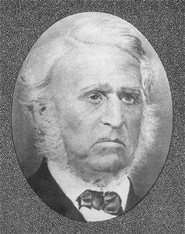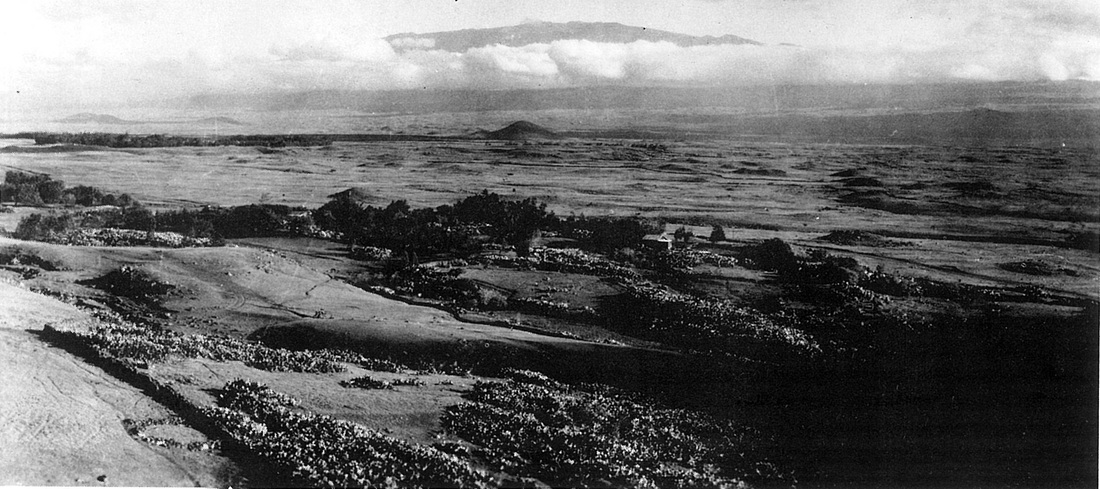We Are One: Parker Ranch and Our Changing Waimea Village
The destinies of Waimea and Parker Ranch were tied together from its inception, blending stiff New England ways with rich, Native Hawaiian Culture. From the beginning Parker embraced the native ways and made them his own. “…he possessed certain personal attributes that instilled respect in all those who made his acquaintance. His quiet, unassuming but self-assured manner made him popular with the natives” (Wellmon, The Parker Ranch: A History).

Parker’s openness to new skills and ways combined with hard work contributed greatly to the early survival of Parker Ranch. Before ranching was really established on the Waimea plains, Parker, working at French’s store, “…listened to the stories and wisdom of the Mexican vaqueros who had come from California to work the mountain cattle. Here with natives congregated about a bright fire blazing in a cavity in the earthen floor…Parker listened attentively as gnarled faces, partially covered by large sombreros and obscured by the dimness of the room, broke out in smiles and nodded in unison to tales concerning life on the large cattle ranches in California where they had grown up” (Wellmon).
On his marriage to Kipikane (granddaugher of King Kamehameha I), Parker was given a small grant of land in Kohala. But the real beginning of the ranch operation centered on a six acre plot near the foothills of Waimea, granted to him on January 8, 1847 under new legislation that challenged the traditional Hawaiian land tenure system; it was here he built his first home at Mana. Three years later, Parker was able to purchase the 640 acres surrounding his homesite. This was augmented by the acquisition of another 1000 acres the following year and the lease of Waikoloa lands from Kamehameha III a year after that.
With hard work and frugal ways, mixed with a Hawaiian style, Parker Ranch became securely established. Parker had 3 almost-grown children – Mary, John and Ebenezer. He set about creating a permanent home and farming/ranching operations centered in Mana.
Parker began to gather a retinue of native workers whom he treated as ‘ohana. This mutually beneficial relationship intertwined the destinies of the ranch and the native residents of Waimea during a transitional time. With the influx of westerners, the challenge of the kapu system by Liholiho and the demise of the old tenant land system the old foundations of life were changing. Parker needed hands to help him operate his growing concern and the Hawaiians needed work.
After Parker died in 1868, having established a prosperous enterprise for his son, John II and grandson Samuel, there were difficult challenges for the ranch. Drought made food scarce, and Kawaihae harbor was destroyed by storm and tidal wave. However, John II continued to run the ranch much in the same fashion as his father, while Samuel attended school on O’ahu.
The fortunes of the ranch changed with the return of Samuel, who enjoyed the ranching life, but had no interest in working it. While he brought an air of levity to the somberness of Mana and made improvements to the houses there, his spendthrift ways and an unwise investment in the newly-established sugar cane industry threatened the survival of Parker Ranch and cause a rift in the family.
Although the ranch was in disarray, the powerful legacy set in place by John Palmer Parker, remained and seemed to take on a life of its own. Parker Ranch saw its salvation arrive in the form of A.W. Carter and Mrs. Elizabeth Dowsett “Aunt Tootsie”, who was the wife of John III (Samuel’s eldest). John III died suddenly and left Aunt Tootsie with one child, a girl named Thelma. Asked by Mrs. Dowsett to protect her share of the ranch, Honolulu Lawyer A.W. Carter on the responsibility with the kind of zeal possessed by John Palmer Parker. Carter was a hard-working man who loved the land and believed in an all-inclusive ‘ohana founded on mutual beneficial endeavor. His willingness to work alongside the cowboy gangs gained the respect of all. “It was common for him to be in the saddle before daylight, riding with the paniolos over rough terrain, working through brush and through heavily-forested areas, helping with the roundups, the brandings”(Joseph Brennan, The Parker Ranch of Hawaii).
Also, like John Parker, Carter took a global view of the stewardship of the ranch and the land on which it depended. He studied every aspect of ranching and acquired adjacent lands (ultimately totaling 330,000 acres), implemented improvements in pasture lands by experimenting with different types of grasses, improved the stock by importing prize breeding bulls and polled Herefore and Holsteins for the dairy. He also created a strong herd of horses in the same manner and instituted a, “…policy of raising thoroughbreds on open ranges like the Parker Ranch terrain [which] contributed tremendously to the net result in the quality of the animal” (Brennan). The fencing of grazing land to prevent encroachments and loss of cattle, and the piping of water to those pastures were also put in place through the efforts of Carter. He was also involved in the reforestation and conservation efforts that improved both the watershed and the general environment of Waimea and Kohala.
In times of bounty, Carter shared the abundance with the ranching ‘ohana by instituing a home ownership program. Through no-interest loans and reasonable payment schedules, it became possible for as many families as desired it to own their own property. “The acquiring of land was, in no sense, for the personal, privated gaind of a few; it was for the good of the many. Carter embroidered old John Parker’s original dream by making the ranch larger, exotic, totally engrossing, profitable and peopled with the families that worked it” (Brennan). Through the auspices of Carter, Parker Ranch also shared its bounty with the Waimea community through educational resources, donations to charitable organizations and care of the elderly.
After the untimely deaths of Thelma (tuberculosis), Henry Gaillard Smart (meningitis) and their infant daughter shortly after her birth, a dark pall seemed to settle on the ranch. Aunt Tootsie clung to the hope offered by young Richard Palmer Smart, son of Thelma and Henry and last remaining heir to Parker Ranch. Under the careful tutelage of both Aunt Tootsie and A.W. Carter, Richard received the education he would one day need to operate the ranch. Although he stayed closely tied to the ranch, in the tradition of his raconteur forbearer, Richard pursed a career in the theater, eventually returning in 1960.
The evidence of the legacy of John Palmer Parker, as carried out by Richard Smart, can be seen in the hundred-plus issues of “Paka Paniolo”, the monthly ranch newspaper published from 1960-1970. His obvious concern for and pride in the Waimea community is clearly expressed in “Aloha ‘Aina”, a column that appears in each issue.
In April 1970 Richard Smart wrote: “When one thinks of Parker Ranch, the average passerby traveling through our lands may only think of the cattle, the horses, the open spaces and the mountains. However, more important than any of these, I feel, are the people – the people that make up the ranch family now, those who have been a part of the past and the younger ones who will be a part of the future. If it weren’t for the wonderful people who make up our group of loyal and hard-working employees, the ranch wouldn’t be what it is today.” These sentiments are signified year after year through programs for employees such as property ownership, profit sharing and educational scholarships.
Plagued by drought and rising costs, the struggle to keep the ranch viable led Smart to sell parcels of land along the coast that were not suitable for grazing. This began with the purchase of the Hapuna / Mauna Kea property in 1963 by Lawrence Rockefeller, followed in January 1969 by the sale of the Waikoloa / Anaeho’omalu property to the Boise Cascade and Signal companies. This was a hard decision; both areas were special gathering places for the ranch ‘ohana. Before there was road access, the children and families of ranch employees boarded boats and gathered to create memories full of laughter, story and song.
Smart’s concern for the Waimea district as a whole though, was evident in his awareness the tradeoffs involved in the march of progress. In 1969 he wrote: “No longer are the Boise Cascade and Signal companies’ developments just plans to be read about in the newspapers and no longer is our village the quiet and remote place we have always known and loved. New faces, new businesses, new advantages, and let us fact it – new problems too, are becoming more evident. Along with the advantages of better shopping, and employment opportunities there are the problems of more traffic, higher prices, and lack of adequate housing.” Smart was seeing the end of an era in Waimea and the surrounding communities.
While Parker Ranch continues as a viable operation, economic exigencies have made it necessary to sell or develop more ranch lands, which will ultimately affect the Waimea community. Waimea and Parker Ranch are like two strong ‘ohi’a trees whose roots and branches have grown together, and just like the ‘ohi’a, the fate of one becomes the fate of the other. While this was the understanding that informed Richard Smart’s vision of Waimea, the question still remains: What will the intertwined destinies of Waimea and Parker Ranch bring next? Will it be possible for Waimea to preserve its unique heritage and its own special brand of ‘ohana and aloha ‘aina?

 RSS Feed
RSS Feed
